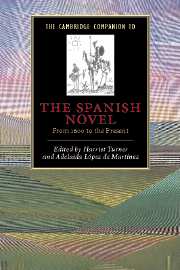Book contents
- Frontmatter
- 1 On the novel: mirror and text
- Part 1 Since Cervantes
- Part 2 The nineteenth century
- Part 3 The twentieth century
- 10 From the Generation of 1898 to the vanguard
- 11 The testimonial novel and the novel of memory
- 12 Questioning the text
- 13 Women and fiction in post-Franco Spain
- 14 Cultural alliances: film and literature in the socialist period, 1982–1995
- 15 The novel beyond modernity
- 16 Writing about writing
- Bibliography
- Index
- Series List
16 - Writing about writing
from Part 3 - The twentieth century
Published online by Cambridge University Press: 28 May 2006
- Frontmatter
- 1 On the novel: mirror and text
- Part 1 Since Cervantes
- Part 2 The nineteenth century
- Part 3 The twentieth century
- 10 From the Generation of 1898 to the vanguard
- 11 The testimonial novel and the novel of memory
- 12 Questioning the text
- 13 Women and fiction in post-Franco Spain
- 14 Cultural alliances: film and literature in the socialist period, 1982–1995
- 15 The novel beyond modernity
- 16 Writing about writing
- Bibliography
- Index
- Series List
Summary
Readers gain a rare and privileged glimpse into the extended, yet implicit, dialogue that all texts possess when writing becomes the object of description, commentary, or meditation in a novel or essay. While commentary by critics and self-reflexive allusions to writing, embedded in the fiction itself, often aspire to the authority of scientific assertions, such reflections form part of complex cultural debates in which good taste, common sense, truth, verisimilitude, and originality are affirmed rather than questioned. As literature evolves, we can easily recognize that the periods of Romanticism and Realism are different; criticism also evolves, reflecting changing cultural perspectives and styles. When Juan Goytisolo writes in Reivindicación del Conde don Julián (Count Julian, 1970) that “erudition deceives,” he alludes to scientific imperturbability and detachment, a view held by certain critics. Criticism’s desire for Olympian stability, demonstrated by Menéndez y Pelayo in the nineteenth century and José Montesinos in the twentieth – each convinced of the propriety of his own values – was seen as opposed to the flux of the novel. In recent decades, concepts steeped in relativity recognize that the vantage point from which we are observing is also in motion and fully engaged with its own time. A close look at how books are represented within novels as well as at the opinions expressed about writing in novels and essays during the modern period will explore this deep commonality between creation and criticism.
- Type
- Chapter
- Information
- The Cambridge Companion to the Spanish NovelFrom 1600 to the Present, pp. 264 - 282Publisher: Cambridge University PressPrint publication year: 2003
- 3
- Cited by



